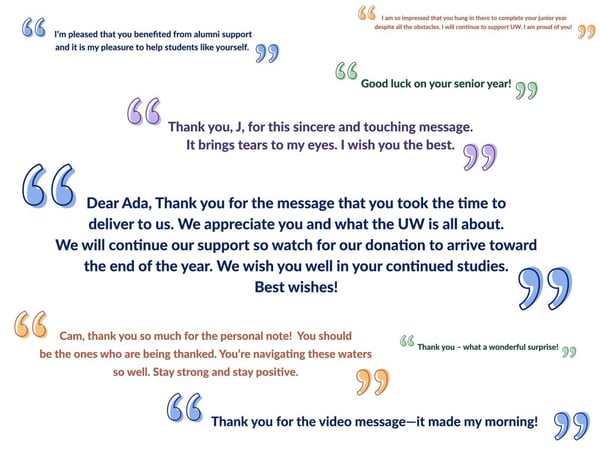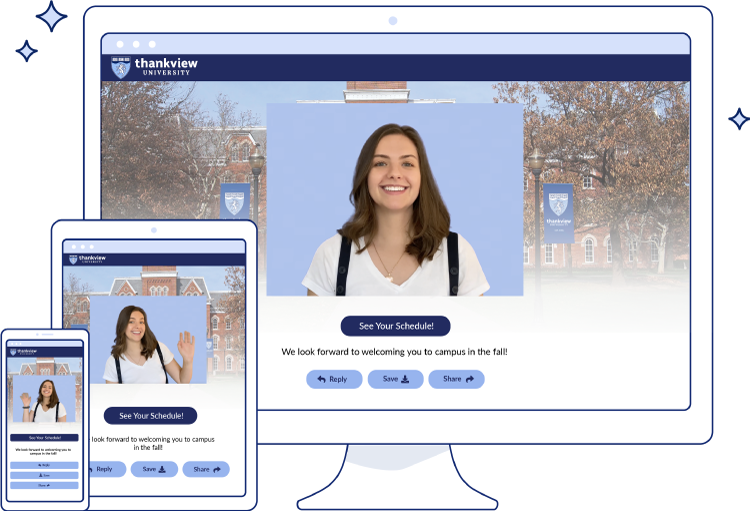How WFAA sent 35,000 unique videos to donors and alumni
TLDR:
- Because of digital tools like ThankView (and a stellar data team!) the University of Wisconsin Foundation and Alumni Association quickly pivoted their spring appeal into a check-in to all current donors.
- 35,000 videos were personalized by name with the help of 7 student workers
- The campaigns average open rate was 50% and they received over 400 replies
The Flamingo in the Room
The Wisconsin Foundation and Alumni Association (WFAA) are no strangers to creative, personal fundraising. (I mean, check out this video of a student marking a donor’s gift for their Fill the Hill campaign. Incredible.)
End of March 2020, it was clear that the WFAA team needed to put their scheduled spring appeals on hold.
Instead of solicitations, the main priority became staying connected to donors through a nationwide shutdown. Check-in emails. No asks.
The biggest project of all was spearheaded by Aimee Furrie, Stewardship Program Manager Annual Giving and Campus Relations, and a team of 7 student call center veterans.
They were going to send a personalized message (beginning each video with a greeting the donor by name) to their entire spring appeal list…35,000 donors and alumni!
Let’s get into how they pulled it off.
The Strategy
The WFAA data team had pulled their current list of donors. The spring appeal’s names and emails were ready to go. What needed to change was the message.
There would be no appeal and no call to action button for this check-in video.
“We thought a lot about how we might want to direct people to a next step. But, we had decided that our goal is to make people feel cared about. And I don’t think that there was a call to action that we could have added to this that would have been accomplishing that goal.”
Aimee Furrie
Aimee and her team split the recipient list into 7 different ThankView campaigns for each student workers to record.
The lists were split by common names so that students could record one video for every common name (read: all the “Johns” were recorded in one video). The students quickly recorded one video for each name and we’re able to move on to their next video.
But the donors were none the wiser, and sent back their own text and video responses mostly addressed directly to the student who recorded their video.
With students working from home on their laptops or smartphones, they completed a training and test video before obtaining access to the ThankView platform. (Note: they were given Recorder permission levels so they would be no accidental sends.)
Once they had sent Aimee a fake ThankView and she approved it, they were added to the ThankView portal and assigned a campaign to work.
The Responses
Though there was no call to action, the donors did respond to the ThankViews. There were over 400 responses to the students’ videos.

The students were given talking points but could write their own scripts. The wording for these videos changed before and after graduation so that the script was current and relevant both to their lives as students and to the donors.
It’s so rare for the call center students to hear responses from their work. But with this campaign, Aimee forwarded each message sent to a student worker directly to them to let them know how much their videos meant to the WFAA family.
How would you recommend getting started with personalized outreach?
Aimee Furrie is the Stewardship Program Manager Annual Giving and Campus Relations at WFAA. Though she works in stewardship at the foundation now, she previously worked in the annual giving offices and has seen life from both sides of the tracks–working on teams with varying levels of resources and staff. Take it away, Aimee!
“I’ve worked in very small advancement shops, so I recognize that it sounds really cool if you have the people to do it [send 35k personalized videos]. While that’s not always the case, I encourage you to find a way to radically personalize your stewardship at whatever level is possible at your organization My first recommendation would be to prioritize your lists.
As a donor goes up the giving ladder or pyramid, whatever you want to call it, the donor traditionally has a closer relationship with the organization. I think that the level of personalization should only grow. So if it feels unsustainable to do this at an annual giving level, then I would say bump it up to the next tier—perhaps leadership annual giving donors. Make sure that you’re being intentional about what is a good long-term solution.
But it’s important to approach both generic and personalized videos more like you are talking directly to a single person. That is really valuable, especially in an attempt to scale videos to reach larger audiences. So the language in the video is not, “all of you people” but it’s “you made a difference.”
Aimee Furrie presented on this WFAA project and the other ways they’re making annual giving personal at EverTrue’s RAISE conference.
